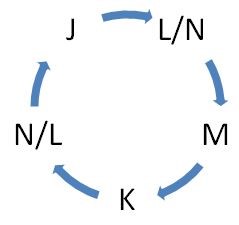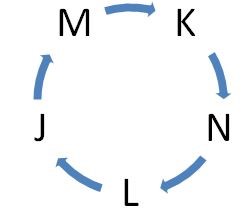Question
J, K, L, M and N are sitting around a circular table
facing the centre. Who are the immediate neighbours of J? I. J is third to the right of K, who is on the immediate left of M. II. N can’t sit adjacent to J. M sits second to the left of L, who is on the immediate left of N. Each of the questions given below has one question and two statements marked I and II. You have to decide whether the data provided in the statements are sufficient to answer the question. Read both the statements and give answer.Solution
From I  Hence I is sufficient to answer the question L and N are J’s neighbours. From II,
Hence I is sufficient to answer the question L and N are J’s neighbours. From II,  L and M are immediate neighbours of J. Hence II is also sufficient to answer the question.
L and M are immediate neighbours of J. Hence II is also sufficient to answer the question.
A number is initially increased by 37.5% and then reduced by 40%. The final value obtained after these changes is 6,270. Determine 80% of the original n...
How many whole numbers between 100 and 750 are multiples of both 18 and 24?
The value of
What is the remainder when 7³⁵ is divided by 5?
What is the value of 1² + 3² + 5² + 7² + 9² ................ 19²?
A student was required to calculate 9/20 of a number, but by mistake he calculated 11/20 of it. His answer exceeded the correct one by 65. Find the number.
The smallest number 'Z' which when divided by 16, 24, and 48 leaves 3 as the remainder in each case. Find the value of ('4Z' + 7).
One-fourth of a number is 70. What will 40% of that number?
...Find the average of the cubes of the first 7 natural numbers.
Relevant for Exams:


